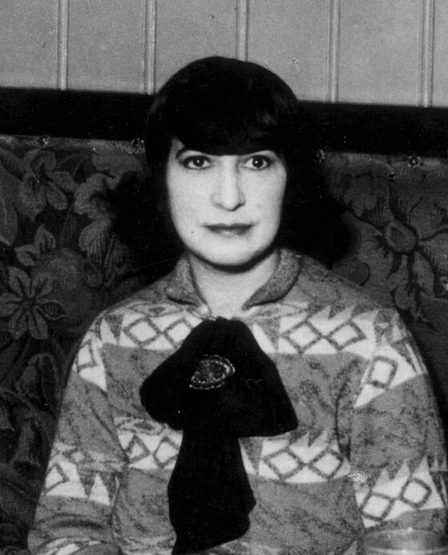Ode to Mary Dorna pseudonym Mary StoppelmanQuirky

Mary Dorna, in a café, circa 1930, Spaarnestad Photo/ National Archives, public domain
This text was translated using AI and may contain errors. If you have suggestions or comments, please contact us at info.ode@amsterdammuseum.nl.
Mary's life was adventurous, colourful, sparkling but ended sadly.
Mary was born on 5 November 1891. Father Aron Stoppelman (textile merchant) and mother Sara Vos first lived on the Weteringschans, later at 177 Kalverstraat. This is where sister Betsy was born.
Mary was a headstrong girl; she disliked the narrow-minded bourgeois aspects of the family. She preferred to sit among the market people on Dam Square and Nieuwmarkt. She wanted to draw and paint and spent hours at the Rijksmuseum.
After a difficult school period. She attended the Sweelinck, H.B.S. Mauritskade, a public school and did an Arts and Crafts course, Mary apprenticed with artist Jan Bleys without graduating. ‘Life's best apprenticeship,’ Mary later said about this.
In 1911, she married Englishman Felix Bowers. The couple live in South America and Germany. When Mary discovers she married the wrong man, she goes to Düsseldorf. There, she lives in a shabby little room and earns a living as a painting model. Through a contact ad, she introduces herself as Maria Jeanne de Videla Dorna from Argentina. She meets Bruno Wille. They marry and go to live in Amsterdam. First in Tweede Jan Steenstraat and later in Den Texstraat. Their house is a gathering place for friends, poets and painters. Mary reads a lot, preferably at night and during the day she sleeps. Stimulated by her husband and live-in brother-in-law, she starts writing. On 24 April 1920, her first story ‘A disturbing apparition’ appears in the newspaper ‘Het Volk’. She initially publishes under the name Mary Wille. Later, she uses the pseudonym Mary Dorna. She then also writes for ‘Het Vaderland’ and ‘Voorwaarts’. In 1932, her collection of short stories, ‘Wanordelijkheden rondom een lastig kind' (Disorders around a troublesome child), was published.’
“When the Second World War breaks out, Mary doesn't get another letter on paper.”
Victor van Vriesland reviewer of the NRC calls her a great talent. In the Groene Amsterdammer she gets her own column ‘Loslippigheden van Mary Dorna’ She writes many biographical stories in which she describes with irony the happiness of small life, full of sympathy for those who, like her, avoid beaten paths.
Her marriage to Bruno also runs aground but they remain friends. Mary marries six years younger Henk Tenklink, a lawyer and art dealer, and goes to live at Prins Hendrikkade 175. The couple are an extravagant presence in Amsterdam cafés, theatres and museums.
When the Second World War breaks out, Mary doesn't get another letter on paper. ‘Something in me is gelahmt,’ she says. Another collection of stories is published in 1940, but due to the war tumult, it goes unnoticed. When she threatened to be deported as a ‘mixed’ Jewess, her ex-husband Bruno Wille managed to convince the Germans that Mary was an Argentine with her made-up name Mary Jeane de Videli Dorna.
Due to the stresses of the occupation, constant use of sleeping pills and drinking too much alcohol, Mary suffers a nervous breakdown. Shortly after liberation, she ends up with paralysis in pavilion 111, the psychiatric ward in the Wilhelmina Hospital. She suffers a succession of illnesses, including as many as 14 cases of pneumonia and numerous broken bones. She has to go through withdrawal treatments again and again. And she even goes blind after a progressive eye condition.
“Mary was an inspiration to writers.”
Still, she comes into the spotlight once more when the short story collection ‘Let's throw father out’ with a selection of her earlier work comes out. The attention does her good. For ‘Tirade’, Mary dictates some more stories to journalist Lida Polak. She gives interviews and VARA airs a television documentary on her work and life.
But the revival does not last long. On 19 March 1971, Mary died at home on Prins Hendrikkade at the age of 79 from a brain haemorrhage, ill and alone. She was buried at the Nieuwe Ooster.
Mary was an inspiration to writers such as Annie M.G.Schmidt and Simon Carmiggelt. The painter Herman Gordijn recognised much in the way she looked at the outside world and made a portrait of her. The actress Hetty Blok recorded a CD of ‘disorder and other stories’ in 2008. The women's writing collective Fixdit produced a reprint of Mary Dorna's collection of stories ‘Let's throw father out the door’ in 2021.
Bronnen:
1001 vrouwen in de 20ste eeuw Els Kloek
https://literatuurgeschiedenis.org
Podcast Fixdit
Period
1891– 1971
About
Ode by Maria Dubbeldam on behalf of De Zaak Muurbloem to Mary Dorna, pseudonym of Mary Jeanette Tenkink-Stoppelman.
She is a forgotten writer someone with a comic oeuvre.

Mary Dorna pseudonym Mary Stoppelman
Mary Dorna, pseudonym of Mary Jeanette Tenkink-Stoppelman (Amsterdam, 5 November 1891 - Amsterdam, 19 March 1971), was a Dutch writer of italics in the years of the interwar period.